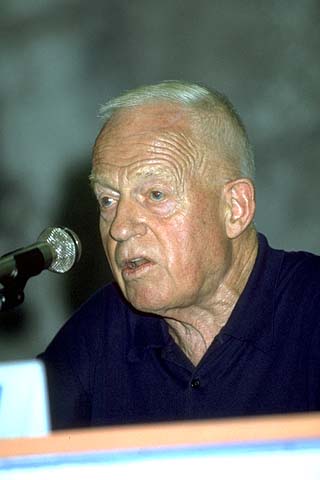From New York to Calcutta… and beyond
‘Congdon was born in 1912 in Providence, Rhode Island, USA. After his BA at Yale university he studied painting, drawing and sculpting. In order not to use weapons during the war he worked as a voluntary ambulance driver on the African, Italian and German fronts. After the conflict he carried on working for the reconstruction of destroyed villages in the Italian region of Abruzzi. Towards the end of the 40s he went back to New York and joined Betty Parsons’ gallery, which had already gathered the main Action Painting artists. During those years and at the beginning of the 50s he produced many works which are now displayed in the main museums of the US and of New York. His great American theme is the city, New York itself. However, Congdon did not settle down in the US and after 1948 his stays in America were shorter and shorter. The paintings exhibited at the Parsons Gallery are a witness to his travels. His journey is a long journey throughout the world. His itinerary was always aimed at the search for peace. Peace can be looked for by those who, like Action Painting artists, can portray on their canvasses the cry in front of an advanced and unliveable world. Congdon travelled through the beauties of civilisations as well as the places of misery in the world. His was a long exile, not from reality, but from the society of appearances and show. Italy became his new home. He finally left the puritan environment which he always attacked, and became a Catholic. In the 60s he painted only intermittently. The artist was busy with his change of life; the commitment to a rediscovered and changed faith was repaid with a difficulty in painting. Nevertheless this time saw the creation of some great works, such as the theme of Christ crucified. The 70s saw Congdon, once the youngest artist of American abstract expressionism, fully regained the strength of expression which characterised post-war years; using Italy as his base, he started to travel the world again, but no longer exhibited. Important works and cycles were born. The cry and peace are not in contrast, instead they cohabit inside a form of art which, for Congdon, always springs from the artist reliance on he who gives life. Congdon has always seen art as a gift; in the same way, the reality expressed in his art is full of a gift. All the works by Congdon, from the African oasis to the tragedy of Calcutta, always express the presence of the absolute in each moment: death and resurrection is the ancient message in his black cities. This extensive exhibition of the works of a great artist who for a long time has preferred not to exhibit his works, if not for some friends, is a gesture of friendship and an exceptional contribution, perfectly in line with the aim of this Meeting.’




